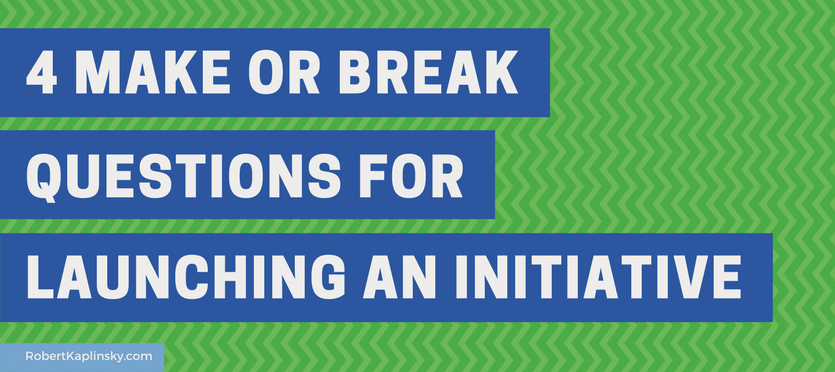If you’re a leader who’s responsible for creating initiatives and getting people to buy into them, then you’ll appreciate this blog post. Let me begin with a story.
Imagine a group of colleagues stating that they need you to address a problem that they are all facing. You spend significant time coming up with a plan for dealing with the problem and eventually present it back to the group. Instead of the appreciation you anticipated, your plan is met with confusion and resistance. They ask why this plan is being forced upon them. They don’t remember ever asking for it and don’t want to do it. That’s pretty much the end of the plan and it isn’t spoken of again.
You might have seen this end result coming. I know I didn’t, and I didn’t understand why until I learned about four questions I needed to ask myself:
- What is the problem? What is the situation that requires this change to solve it?
- Who says so, and on what evidence?
- What would occur if no one acted to solve this problem?
- And what would happen to us if that occurred?
The questions come from the book Managing Transitions by William Bridges. I’ve learned that when I don’t have solid answers to each of those questions, I either need to find out what the answers are or abort the initiative because it’s set up for failure.
In the story above, I was able to answer the first question well enough because they told me about it. Where I broke down was with the second, third, and fourth questions.
I thought that that they were the ones who said that this was a problem that needed addressing. That wasn’t their recollection. Apparently something had changed between when they first described the problem to me and when I presented my plan to them. Additionally, they also didn’t see it as much of a big deal if nothing was done about it. It just looked like I was the one who was pushing to make the change with no evidence that it was needed.
- The problem is that we do not currently have textbooks aligned with the new standards and we either have to purchase new ones or develop our own curriculum.
- The state department of education (or equivalent) requires students to learn the current standards.
- If we did nothing, we would be out of compliance and students would not be learning the state adopted standards.
- If that occurred, we could be legally liable and student test scores would likely decline.
In a situation like this, the process is more likely to go smoothly. What’s important is not just that you have answers to the questions but that you communicate the answers to those questions to everyone. When they hear those answers, they are more likely to buy in to the plan than if there had been no answers at all.
As Bridges explains in the book:
You need to explain the purpose… clearly. You may discover that people have trouble understanding the purpose because they do not have a realistic idea of where the organization really stands and what its problems are. In that case, you need to “sell the problems” before you try to sell a solution to those problems. If that wasn’t done… now is the time to provide answers to these questions.
I hope this has been helpful for you. I know it was something I wish I had known earlier.


Wow! This is so helpful. I have 2 big initiatives to roll out this fall and this is a game-changer. Definitely going to read the book, too. Thank you!
Great timing Amanda! Hope this helps you avoid many of the mistakes that were only obvious to me long after it was too late to change them.
This EXACT thing recently happened to me with something my team had complained about forever. I worked long hours to find and present solutions only to hear comments like “Why do we have to do this?” “Who said this is an issue?” “I don’t want to change what I do.” and others. After all the thought and effort I put in, I was expecting a huge THANK YOU, not so much push back that all plans were abandoned. Thanks for this post. It’s incredibly timely for me and the four questions will help me to frame things I do in the future in the hopes of a more positive outcome for everyone.
I wish I didn’t feel ya so much. This is a crummy situation to be in and I hope these questions help you going forward.
This is fantastic. Another book I would recommend is To Sell Is Human by Daniel Pink. He does a great job taking the “icky” out of sales and sharing how sales principles can help communicate w.it’s a team.
Thanks for this, Tim. I’ll add that to my list. I’ve read one book by Pink on motivation and enjoyed that.